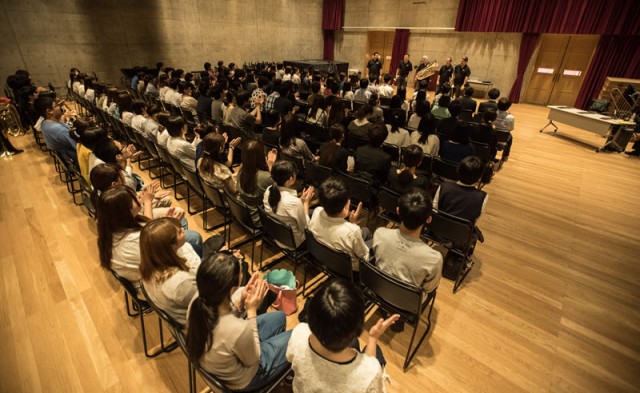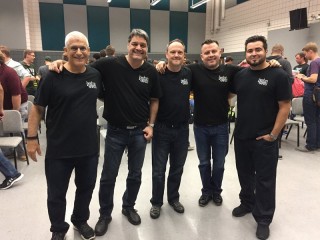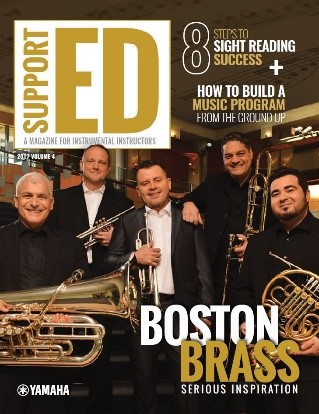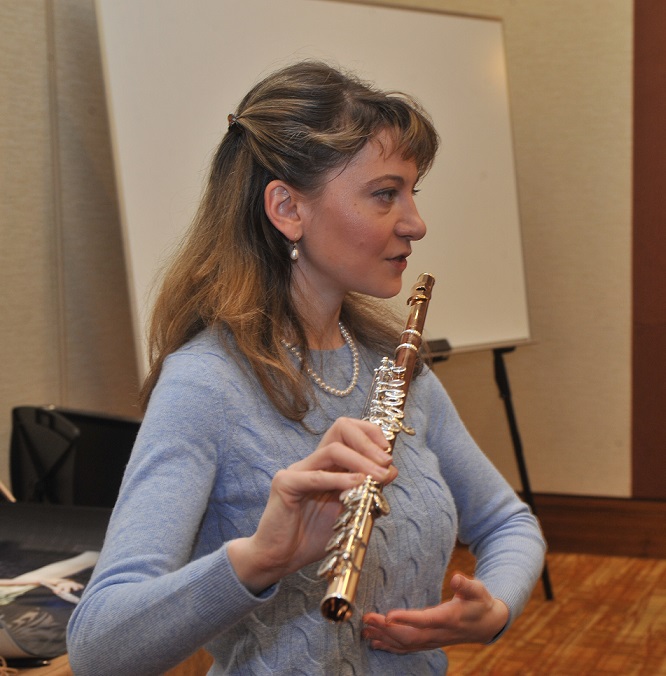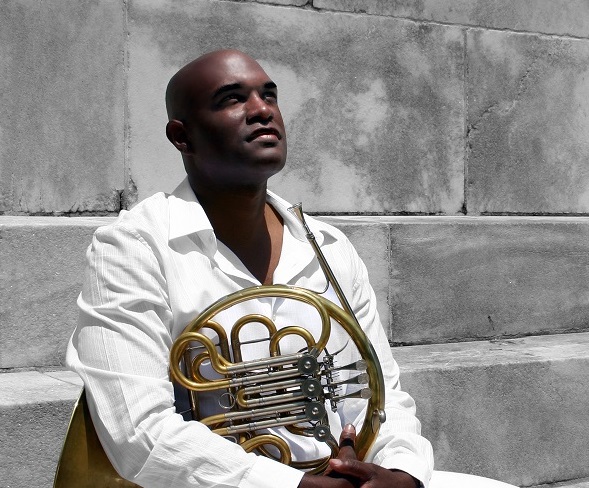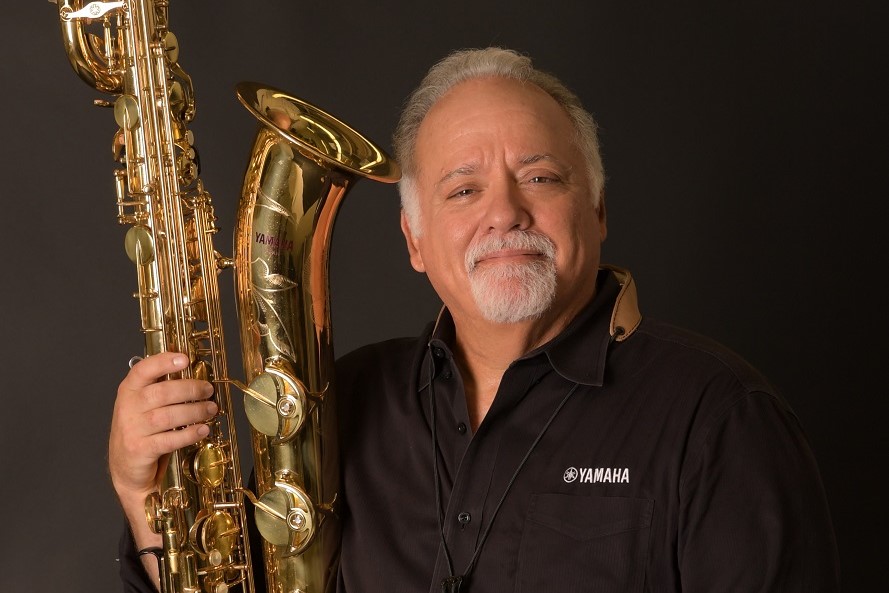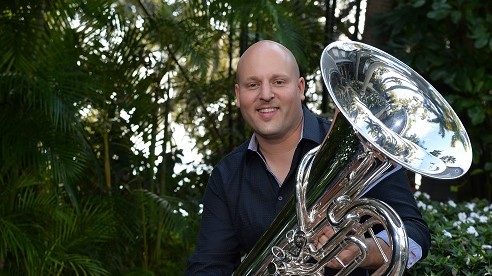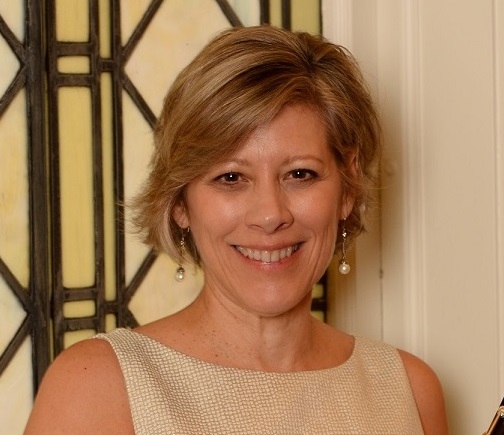Tagged Under:
Boston Brass’ Quest to Educate Young Musicians
The Boston Brass entertains audiences worldwide with its range of repertoire and boisterous fun, but its primary mission is to advocate for education for all musicians.
As you might have guessed, the Boston Brass is a brass quintet originally formed in Boston.
“If there’s a day that goes by that we don’t teach or do a clinic, it feels like it was empty,” says tuba player Sam Pilafian. As the ensemble travels around the world giving performances, its members make plans to include as many clinics, master classes and guest artist concerts as possible. “We are on the road 180 days a year,” explains trumpet player Jeff Conner. “Part of our mission is to leave as big a footprint as we can wherever we are with music education.”
Reverence for music teachers is coded in the group’s DNA. In every performance, the Boston Brass asks all past, present and future music educators to stand for a round of applause. “[At] every concert, no matter where we are in the world, I … always say that I would not be on stage if it were not for my middle school and high school band directors,” reports Conner. “And I think all of us in the group have had these experiences.”
Horn player Chris Castellanos always recognizes his mentors. “I was fortunate to have a great band director in Las Vegas named Ed Jackson,” says Castellanos. “He always made it a point to challenge us with fun assignments. He turned practicing into a game, which in turn got a lot of kids interested who would’ve otherwise not practiced at all.”
Joining Forces
In 1986, Conner founded the Boston Brass — modeled after the Empire Brass — while he was a student at Boston University. Thirty-one years later he’s the only original member and the only one that actually lives in Boston. Yet Conner stresses the group has no leader. “What’s unique about the group is we’re all equal partners,” he says. “That’s something that we really think works best.”
In addition to Conner, Castellanos and Pilafian, the group includes trumpet player Jose Sibaja and trombone player Domingo Pagliuca. Thanks to today’s technologies, they often write, arrange and rehearse music remotely, then arrive at their next location a day early in order to rehearse for a full day before performing or teaching.
“When we’re in real time, it’s a pleasure, and a lot of the gist of what has to happen has happened,” says Pilafian. “We combine the digital life with seeing each other live, and then you have two families: Boston Brass and our real families.”
Serving All Students
To prepare for clinics, the group likes to communicate with band directors in advance whenever possible. This early planning makes the clinics more dynamic and tailored for specific students. “We will be in touch with the director ahead of time, and we’ll ask them: ‘What would you like for us to cover during the course of the clinic?'” explains Conner. “[If] they have a specific need, we will definitely address it. We are very flexible.”
Sometimes just hearing a clinician say something — even when their director has said the same thing for weeks on end — can be the best way to reach the students. “They pay just a little bit more attention, or it’s delivered in a different accent, or they hear it on a different level, and they run with it right afterward,” says Pilafian. “Sometimes it’s simply the change of scenery that causes the breakthrough.”
All five members of the Boston Brass participate in the clinics unless they are in residence for a longer period of time, when they may break into more specialized workshops. Their clinics apply to all musicians of all types and levels, from elementary school to college as well as adult community groups.
The Boston Brass makes sure to tell the directors that all members of their school or organization are welcome. “Our clinics aren’t brass-specific, so everything we talk about is for all musicians,” Conner says. “We always let the directors know that … if they want to have orchestra students or choir students, they are welcome as well.”
Sometimes the quintet even gets to participate in halftime shows. The Boston Brass played with the James Madison University Marching Royal Dukes in Harrisonburg, Virginia, on its high school band day earlier this season. “There were [more than 1,000] people on the field, 750 of them were high school students, and we did two clinics for all the players; [the clinics] were so big that we had to put them in a basketball arena,” Pilafian says. “That’s satisfying. That feels like a great day’s work that we got to touch that many people and influence that many people. That felt good flying home on the day after that game.”
For Your Lungs and Ears
In addition to the director’s requests, some of the most common topics covered in the Boston Brass clinics include breathing technique, increasing sound, breaking down rhythms and improving dynamics. Pilafian is coauthor of the popular, Emmy-winning “The Breathing Gym” exercise book and DVD, so that is one of the pillars of the Boston Brass’s teaching and playing.
“We’re a living lab of ‘The Breathing Gym,’ and so it’s one of the things we spend a lot of time doing,” explains Pilafian. “It makes the band sound better and only takes three to five minutes. It’s addictive because you’re getting better.”
The Boston Brass always encourages students to listen to professional musicians as much as possible. “Have an open ear to all music and listen to music played by a professional that performs on your instrument,” says Pagliuca. “You will grow as far as your ears grow. The more you listen to great music, the better you will be as a musician.”
Generations of Perspective
The group’s respect for educators came full circle four years ago when Pilafian decided to join as a member of the group after his retirement from teaching in colleges. “I’ve known Jeff since he was a teenager, and he fell in love with brass chamber music,” Pilafian says. “He built this incredible career for the group, and I didn’t realize he was building my retirement at the time, but that’s what happens.”
For Conner and the other Boston Brass members, performing with Pilafian is a dream come true. “It’s incredible,” says Conner. “I never would have imagined that Sam would be playing in the quintet when he was coaching us as students 30 years ago at Boston University.”
Pilafian enjoys the unusual arrangement. “It’s your job as an older professional to stop treating students like students when they become great and acknowledge the fact that they’re now your colleagues,” he says. “We’ve got years and years of experience, but we have generations of perspective on the same piece of music, so we’re all learning from each other.”
Top photo by Rob Shanahan for Yamaha Corporation of America
Photos courtesy of Boston Brass
This article originally appeared in the 2017 V4 issue of Yamaha SupportED. To see more back issues, find out about Yamaha resources for music educators, or sign up to be notified when the next issue is available, click here.










